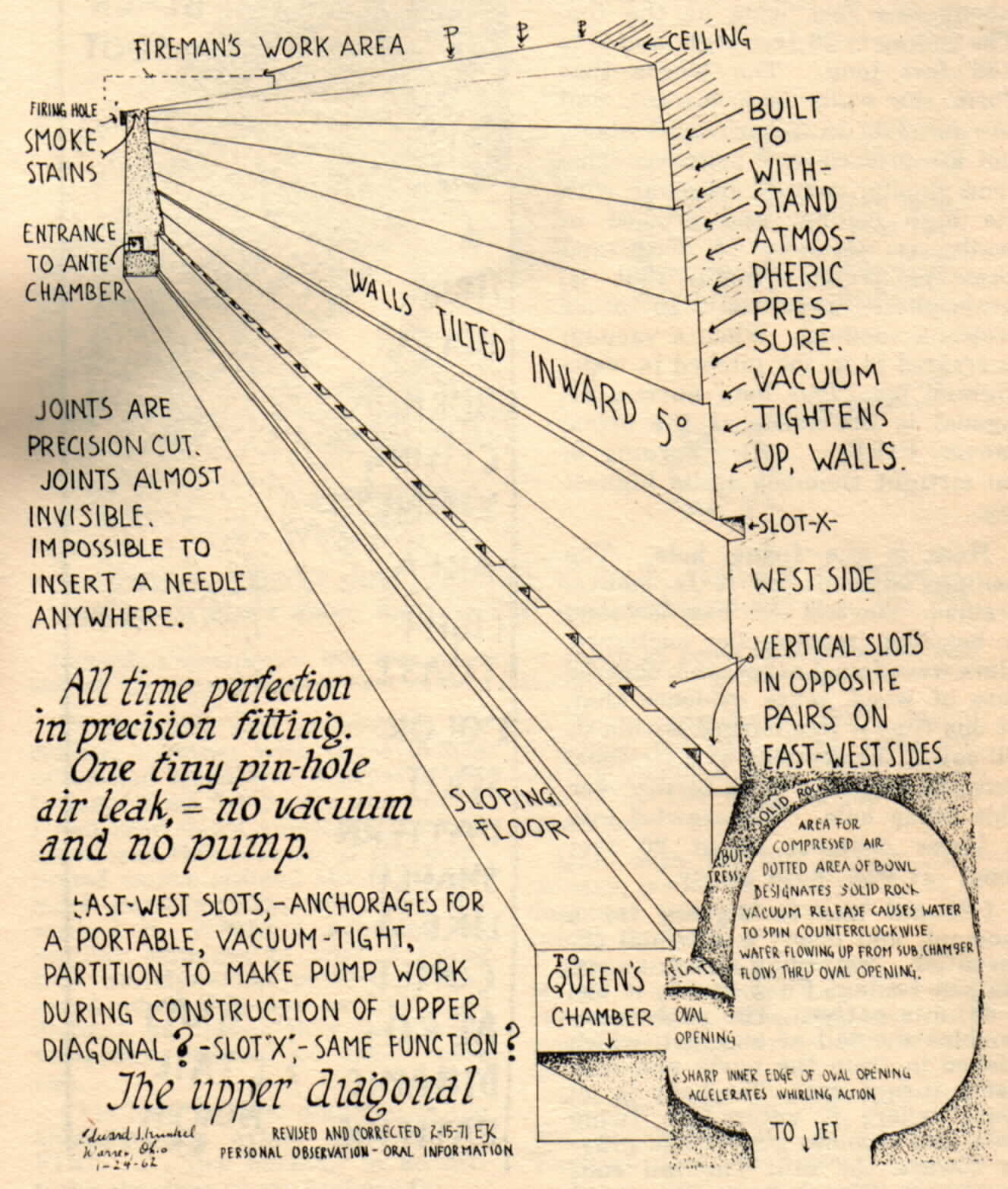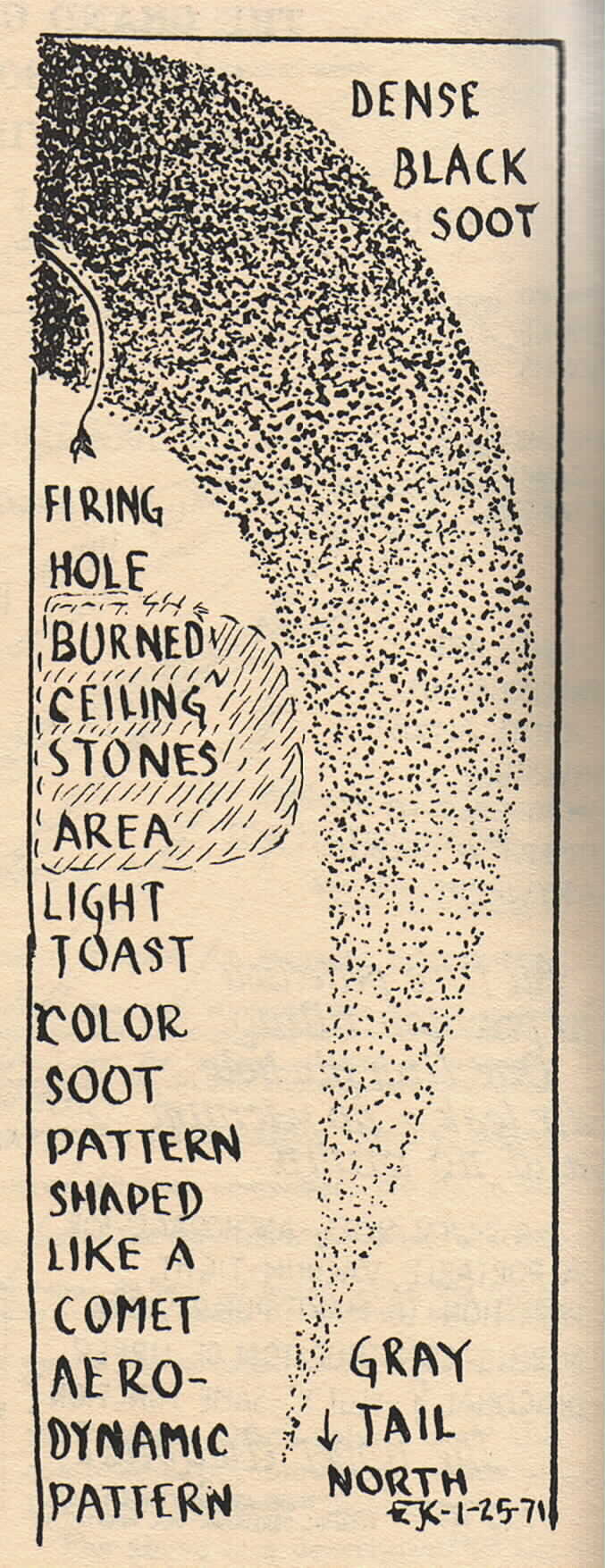

One of the most interesting aspects of this pump is that the column of water is raised using two forces. The partial vacuum created above, raises the column of water. Also, the compressed air in the subterranean chamber lifts (like a water ram type of pump) the column of water from below. These two forces acting together make this a very efficient pump. Plus, the fire does not "go out" or become extinguished after each cycle. The fire "smolders" after it creates the partial vacuum, then "flares up" when the vacuum seal is released.
Below are excerpts from the Book Pharaoh's Pump.
The upper diagonal, which is called the Grand Gallery, is also strangely
made. It is less than seven feet wide at the bottom, and about two
feet wide at the top. The ceiling is 28 feet high, and it is 156
feet long. The blocks that form the walls lean inward, and are not
laid in a horizontal plane, but are pitched in, 5 degrees. This long
sloping narrow diagonal, which its high ceiling, and pitched in walls is
designed to withstand pressure from without, that is, atmospheric pressure.
In other words a vacuum. When a vacuum is created in it, the pitched
in walls tighten up. This long narrow diagonal is the abode of the
prime mover, FIRE, . . . fire burning in an airtight chamber at
its highest tip.
For some unknown reason, no author, in all the literature that has
been printed, has ever mentioned this soot pattern on the ceiling of the
upper diagonal.
Here is the firing hole. The ceiling adjacent to it is smoke-stained.
Beyond this hole is found a box-like, rectangular enclosure. Here
were found ashes, and charred bits of wood, mute evidence that, at one
time a fire burned within it. I’ll call it the remains of a fire-box.
Davison was the first to discover this firing hole. “He crawled into
a lower chamber about 20 feet long. It was quite empty.”
I would like to digress for a moment, and insert a personal observation
regarding the smoke stained ceiling. First of all, it has a definite
pattern. The pattern resembles the tail of a comet, which rushed
in from the north and suddenly turned east. The body is jet black
where it enters the firing hole, and becomes grayer and grayer toward the
tail. The tail ends in a point. The whole smoke or soot pattern,
looks as if it might have been fashioned with a huge French curve.
The tail is about 12 feet in length. It is definitely of aerodynamic
design, caused by the violent movement of air rushing in.
Close to the firing hole is a discoloration of a ceiling slab; about
the color of light toast,. This light toast area indicates that here
is the spot of nearly perfect combustion. I’ll guess that this soot
black residue is the result of oil soaked wood, ignited in the fire box.
Soaking the wood in oil would cause almost instantaneous ignition.

I’ll hazard another guess; that for the most part, this passage
is filled with bat dung, and comes out near the 120 foot level.
Details of this fire-box are elusive. Details may be recorded
somewhere, but as yet, I have not found them.
I’ll guess again; that this fire-box was covered with a single slab
with a hole in it, and that the hole was covered with a flat stone lid
— that the lid and slab were ‘ground in’ with a fine abrasive, in the same
manner we ‘grind in’ valves to seats, to make them compression-tight, and
vacuum-tight.
Add a thin layer of oil to these ‘ground in’ members, and we have a
very effective vacuum seal. Its modern counterpart is the bell-jar,
the rim of which is ground upon a flat glass surface.
There is no part of the interior that is ordinary, or conventional.
All parts are oddly made, and from an ordinary viewpoint, the whole layout
of the interior defies a reasonable explanation. But, when the interior
is regarded as a pump, this odd construction, makes sound engineering sense,
indeed!